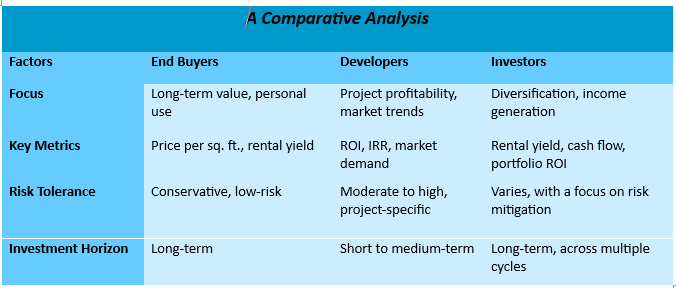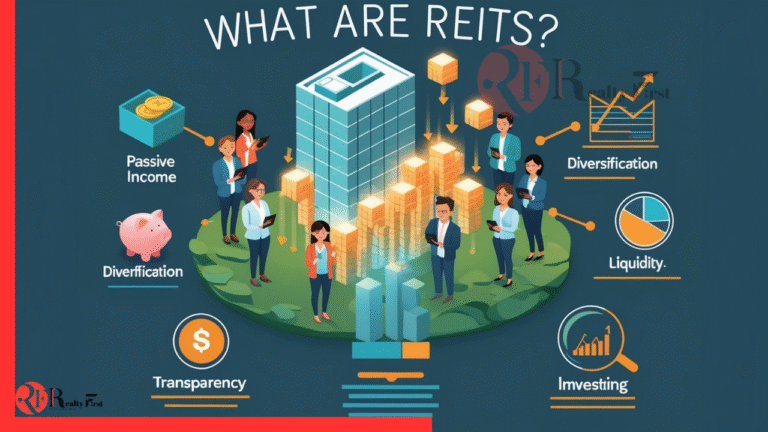By Pushpamitra Das, Founder & Director JUSTO
Property appreciation is the bedrock of real estate investment, representing the increase in a property’s value over time driven by a complex interplay of social, economic, and environmental factors. Key drivers include advancements in infrastructure, prime location, reputable developers, proximity to commercial hubs, and favourable demographics. Additionally, economic indicators and evolving regulatory policies play significant roles in shaping market dynamics and boosting property values. Understanding these factors is essential for stakeholders aiming to maximize the potential profit from their real estate investments.
However, not all stakeholders in the real estate market evaluate appreciation in the same way. End buyers, developers, and investors each have distinct goals and strategies that shape their approach to valuing property appreciation. Taking a closer look at each perspective, we will highlight the unique criteria and metrics that they use to measure growth potential.
End Buyers: Prioritizing Long-Term Value and Personal Use
For end buyers such as individual homeowners, property appreciation is primarily about securing long-term value and achieving future financial gains. Their purchasing decisions are influenced by lifestyle preferences, anticipated capital gains, and potential rental income. The key factors they consider include:
1. Neighbourhood Growth and Amenities: End buyers prioritize properties in well-established or rapidly developing neighbourhoods. Proximity to good schools, healthcare facilities, parks, and shopping centers can significantly enhance a property’s appeal, leading to steady appreciation. Areas with upcoming infrastructure projects, like new metro lines or highways, are particularly attractive due to their potential to enhance future property values.
2. Price Comparisons and Market Trends: End buyers typically assess the price per square foot and compare it with similar properties within the same area. Historical price trends and recent sales data provide reliable benchmarks for evaluating appreciation potential. Many buyers also rely on local market reports and real estate agents for insights into growth prospects.
3. Rental Yield and Capital Gains: For buyers interested in investment properties, rental yield is a key consideration. A property with strong rental demand and consistent income can offer a good return on investment while also benefiting from long-term capital appreciation. End buyers tend to prefer stable, low-risk investments, focusing on properties with reliable income streams.
Developers: Maximizing Project Profitability and Market Dynamics
Developers take a more strategic, project-driven approach to valuing property appreciation. Their goal is to maximize the profitability of a development within a specific timeframe, often using advanced financial metrics and market forecasts. Key aspects of their approach include:
1. Return on Investment (ROI) and Internal Rate of Return (IRR): Developers focus heavily on ROI and IRR to assess the financial viability of a project. These metrics help determine whether the project will deliver sufficient returns relative to the costs and risks involved. IRR, in particular, accounts for future cash flows and helps developers gauge the time value of money, making it a critical tool for evaluating long-term projects.
2. Market Demand and Economic Indicators: Developers closely monitor macroeconomic trends, urbanization rates, and shifts in consumer behaviour. Factors such as rising disposable incomes, favourable government policies, and infrastructure development can drive demand for both residential and commercial properties, influencing appreciation.
3. Exit Strategy and Project Timeline: Developers often plan their exit strategy early in the project lifecycle. They evaluate appreciation potential based on project timelines, construction costs, and anticipated market conditions. This allows them to adjust pricing strategies or explore alternative uses, such as converting residential projects to commercial spaces, to optimize returns.
Investors: Diversification and Income Generation
Investors, both institutional and high-net-worth individuals, approach property appreciation with a focus on diversification and income generation. For investors, positive appreciation is crucial as it underpins cash flow and overall returns. Their strategies are shaped by a broader portfolio perspective, emphasizing risk management and long-term growth. Key elements of their approach include:
1. Asset Diversification: Investors typically diversify their real estate portfolio across different asset classes, including residential, commercial, and industrial properties. By spreading their investments, they mitigate risks and enhance the potential for capital appreciation. For example, including income-generating assets like office spaces or warehouses can provide steady cash flow while waiting for residential properties to appreciate.
2. Focus on Cash Flow and Rental Yields: Unlike end buyers, investors focus on properties that offer strong cash flow. High rental yields and long-term leases with reputable tenants are critical factors for assessing appreciation potential. Investors look for assets that can deliver consistent income, even during market downturns.
3. Macro and Microeconomic Analysis: Investors use a combination of macroeconomic indicators (GDP growth, inflation rates and interest rates) and microeconomic factors (local employment rates, property supply and demand) to gauge appreciation potential. They rely heavily on market data, industry reports, and financial modeling to make informed decisions.
Leveraging Technology for Accurate Property Valuation and Appreciation Projections
There is a growing trend where technology is transforming the way property valuations and appreciation forecasts are conducted. Advanced data analytics, artificial intelligence, and machine learning tools enable a more precise assessment of property values by analyzing a broad range of factors, from historical price trends and neighbourhood growth to economic indicators. Geographic Information Systems (GIS) and remote sensing tools add depth by mapping environmental factors and infrastructure developments. Additionally, AI-driven algorithms can provide predictive insights into future appreciation trends by integrating macroeconomic data, demographic shifts, and market dynamics. For end buyers, developers, and investors, these technological advancements offer a data-driven, reliable approach to make informed, future-proofed investment decisions.
To sum up, the approaches for assessing property appreciation differ widely among end buyers, developers, and investors, each guided by distinct goals and risk profiles. While end buyers prioritize lifestyle benefits and long-term capital gains, developers focus on project profitability and market timing. Investors take a broader view, balancing income generation with potential appreciation through diversified portfolios.
Recognizing these varied perspectives, along with the role of technology, is essential for navigating the real estate market successfully. By understanding the motivations behind each stakeholder’s decisions, investors can refine their strategies, align their risk tolerance, and seize emerging opportunities. As the market evolves, embracing technology and maintaining a flexible and comprehensive approach to valuation will be key to achieving sustainable and robust returns.














